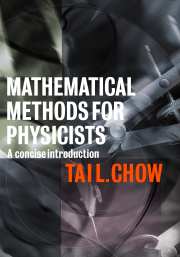Book contents
- Frontmatter
- Contents
- Preface
- 1 Vector and tensor analysis
- 2 Ordinary differential equations
- 3 Matrix algebra
- 4 Fourier series and integrals
- 5 Linear vector spaces
- 6 Functions of a complex variable
- 7 Special functions of mathematical physics
- 8 The calculus of variations
- 9 The Laplace transformation
- 10 Partial differential equations
- 11 Simple linear integral equations
- 12 Elements of group theory
- 13 Numerical methods
- 14 Introduction to probability theory
- Appendices
- Further reading
- Index
5 - Linear vector spaces
Published online by Cambridge University Press: 04 August 2010
- Frontmatter
- Contents
- Preface
- 1 Vector and tensor analysis
- 2 Ordinary differential equations
- 3 Matrix algebra
- 4 Fourier series and integrals
- 5 Linear vector spaces
- 6 Functions of a complex variable
- 7 Special functions of mathematical physics
- 8 The calculus of variations
- 9 The Laplace transformation
- 10 Partial differential equations
- 11 Simple linear integral equations
- 12 Elements of group theory
- 13 Numerical methods
- 14 Introduction to probability theory
- Appendices
- Further reading
- Index
Summary
Linear vector space is to quantum mechanics what calculus is to classical mechanics. In this chapter the essential ideas of linear vector spaces will be discussed. The reader is already familiar with vector calculus in three-dimensional Euclidean space E3 (Chapter 1). We therefore present our discussion as a generalization of elementary vector calculus. The presentation will be, however, slightly abstract and more formal than the discussion of vectors in Chapter 1. Any reader who is not already familiar with this sort of discussion should be patient with the first few sections. You will then be amply repaid by finding the rest of this chapter relatively easy reading.
Euclideann-spaceEn
In the study of vector analysis in E3, an ordered triple of numbers (a1, a2, a3) has two different geometric interpretations. It represents a point in space, with a1, a2, a3 being its coordinates; it also represents a vector, with a1, a2, and a3 being its components along the three coordinate axes (Fig. 5.1). This idea of using triples of numbers to locate points in three-dimensional space was first introduced in the mid-seventeenth century. By the latter part of the nineteenth century physicists and mathematicians began to use the quadruples of numbers (a1, a2, a3, a4) as points in four-dimensional space, quintuples (a1, a2, a3, a4, a5) as points in fivedimensional space etc. We now extend this to n-dimensional space En, where n is a positive integer. Although our geometric visualization doesn't extend beyond three-dimensional space, we can extend many familiar ideas beyond three-dimensional space by working with analytic or numerical properties of points and vectors rather than their geometric properties.
Information
- Type
- Chapter
- Information
- Mathematical Methods for PhysicistsA Concise Introduction, pp. 199 - 232Publisher: Cambridge University PressPrint publication year: 2000
